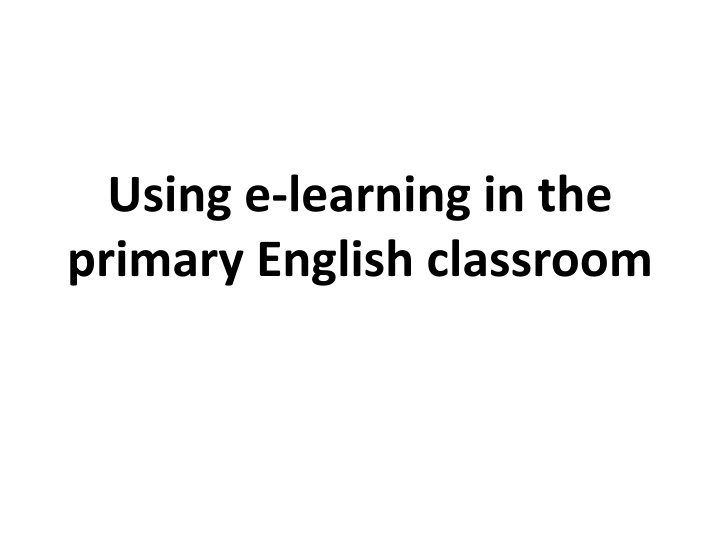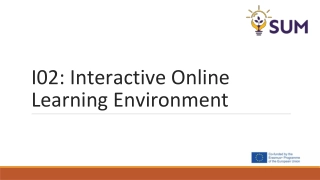Enhancing English Learning Through E-Learning Tools
Explore the effective integration of e-learning tools in the primary English classroom to improve student engagement, interactivity, and independent learning. Discover a range of applications like locational-based learning, learning management systems, and presentation modes to cater to diverse learners and provide instant feedback.
Download Presentation

Please find below an Image/Link to download the presentation.
The content on the website is provided AS IS for your information and personal use only. It may not be sold, licensed, or shared on other websites without obtaining consent from the author.If you encounter any issues during the download, it is possible that the publisher has removed the file from their server.
You are allowed to download the files provided on this website for personal or commercial use, subject to the condition that they are used lawfully. All files are the property of their respective owners.
The content on the website is provided AS IS for your information and personal use only. It may not be sold, licensed, or shared on other websites without obtaining consent from the author.
E N D
Presentation Transcript
Using e-learning in the primary English classroom
What is e-learning? e e means various electronic computer, networks and multimedia). L Learning is the focus focus of e-learning. e e also means efficient, effective and enjoyable. efficient, effective and enjoyable. electronic tools (such as
e-learning and its application in English learning and teaching Overview of tools more relevant to English learning and teaching Type Example QR Code + Google Form, EduVenture, Beyond Campus Purpose Application To facilitate outdoor mobile learning and teaching To enhance inquiry- based learning Ask students to use QR Code at each checkpoint to look for information from the web and then fill in information in a Google Form Locational- Based Learning system Classroom responses system Socrative, Plickers, Kahoot, Padlet, NearPod, Lino, Quizlet Edmodo, Schoology, Moodle, Google Classroom To increase interactivity To facilitate instant feedback Set questions to assess a target language pattern in Kahoot and ask students to answer the questions using mobile devices Post readings on Edmodo, invite students to give their views and set questions (e.g. MCs) to track student learning To share, integrate and create resources To access materials and track student learning anytime, anywhere Learning manage- ment system
Example Doceri, Popplet, Skitch, Screen Chomp, Explain Everything, Prezi, Educreations, Videolicious Purpose To create a variety of presentation modes such as mindmapping, video making, storytelling and idea sharing Application Ask students to use Popplet to design a mindmap to help them organise their writing ideas Idea presentation apps Camera for phototaking and filming, dictionary, voice recording To maximise the use of tablets To complement the use of other e- tools Ask students to film their presentation in class with a tablet and then upload the file on to Edmodo for sharing and feedback Built-in functions of tablets
Why e-learning Objectives To improve students independent learning To cater for learner diversity To increase interactivity in class To facilitate instant feedback
Experience sharing Acknowledgements Ms Nancy Chan Ms Maggie Ting ~ Baptist (Sha Tin Wai) Lui Ming Choi Primary School
Background of using e-learning in the English Department Challenges Student level - Students may not take the initiative to work independently after class to consolidate and extend their learning. - There is learner diversity. Flexibility in teachers use they can select the most efficient, effective e-tools and make optimal use of them Teacher level - The interaction mode in class is often limited. - There is a lack of time for teachers to give timely and individual feedback. they can maximise learning and make learning enjoyable e-Learning as an established practice (started 4 years ago) Expected learning outcomes: To improve students independent learning To cater for learner diversity To increase interactivity in class To facilitate instant feedback
Classroom application 1 Level: P3 Ability of students: English proficiency: vary from very weak to very capable IT skills: average (1 year s experience) Learning objectives: Students will be able to: write and record a simple recipe use appropriate action verbs
Brief lesson flow 1. Routine: read aloud a text 2. Learn the success criteria of recording a recipe (e.g. use of action verbs). 3. Use an app called Videolicious to record videos of making a dish. 3. Use an app called Videolicious to record videos of making a dish. 3. Use an app called Videolicious to record videos of making a dish. 4. Share recordings in class by using Apple TV. 5. Submit videos to Google Classroom . 5. Submit videos to Google Classroom .
How it adds value to learning and teaching Enhance students engagement and motivation Students are motivated by this new way of interaction and publishing They are willing to participate and can finish the task by themselves. They enjoy listening to their recordings again and improve their work.
How it adds value to learning and teaching Cater for learner diversity Students can finish the task and edit the work at their own pace. While faster students review and record again, teacher can help those in need. The less able ones are more confident and willing to speak. BACK BACK
What if we do not have enough time to watch all videos in class How? 1. Students can upload the videos on to Google Classroom at home. 2. Teacher can give feedback after watching. 3. Teacher can also choose and share some good videos from Google Classroom with other students.
How it adds value to learning and teaching Cater for learner diversity The less able ones can learn from the more able ones. Teachers can assess the work of individual students and give them feedback. New possibilities in learning Speaking homework is possible. Teachers can give feedback online and enhance T-S interaction.
How it adds value to learning and teaching Better organization All class materials (e.g. the videos students made) are automatically filed into folders in Google Drive. Students can track their own learning across years. Teachers can pick good examples as teaching materials.
Classroom application 2 Level: P5 Ability of students: English proficiency: vary from very weak to very capable IT skills: quite good (4 years experience using tablets) Learning objectives: Students will be able to: differentiate clauses of purpose, result and reason use so , so that and because make sentences using so , so that and because
Brief lesson flow 1. Routine: read aloud a text 2. Learn the target language so , so that and because . 3. Do a quiz in Socrative to assess the learning of so and so that . 3. Do a quiz in Socrative to assess the learning of so and so that . 3. Do a quiz in Socrative to assess the learning of so and so that . 4. Have a competition using Kahoot to practise so , so that and because . 5. Make sentences with so , so that and because and submit them to Edmodo . 5. Make sentences with so , so that and because and submit them to Edmodo . 5. Make sentences with so , so that and because and submit them to Edmodo .
How? 1. Teacher posts instructions of homework on Edmodo. 2. Students consolidate their learning by typing sentences with so , so that and because and submit them on to Edmodo at home. 3. Teacher gives feedback. 4. Peers can also give feedback.
How it adds value to learning and teaching Cater for learner diversity The less able students can read the work done by others and learn from their peers. Track independent learning progress Provide an alternative way to track if students have worked independently after class.
Way forward Review students readiness regularly when to use the tools e.g. promote group editing in Google Classroom in senior forms Set up learning community in and beyond school support one another more efficient, effective use of different e-learning tools and resources plan how and
Tips Establish a monitoring system IT restrictions to block forbidden Apps Monitor through mobile phones by IT staff Monitor students online time and browsing history by class teachers Prepare students and parents Students (e.g. etiquette, rules and regulations (IT contract)) Strict discipline Parents (e.g. parents meeting with the principal) Can e-learning add value to learning and teaching? Do we plan a unit carefully and holistically to ensure the right technology is added to the right task and used at the right time?























